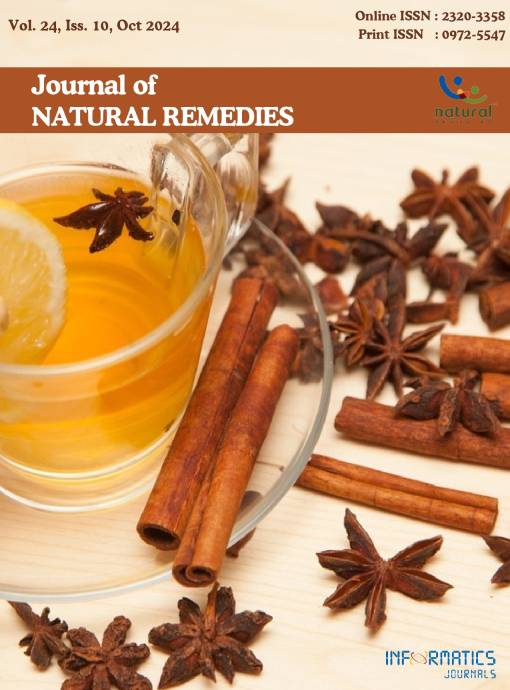Pharmacognostical Study and Analytical Standardization of Bhringaraja Taila: An Ayurvedic Oleaginous Medicine
DOI:
https://doi.org/10.18311/jnr/2024/36239Keywords:
Murchanna, Sneha Kalpana, Sneha Paka, StandardizationAbstract
Background: Bhringaraja Taila is an Ayurvedic classical formulation. The formulation is indicated as keshaya. The present study is structured around validating the fact of preparing the formulation with and without the addition of mineral (Gairika). Aim: The objectives of this study were to prepare and analyze Bhringaraja Taila. Method: After performing the murchanna samsakara, a specified amount of Drava, Kalka and Sneha dravyas were taken and subjected to moderate heating till the watery portion evaporated Bhringraja Taila prepared with and without Gairika. Results: The refractive index of Bhringraja Taila with and without the addition of Gairika was found to be decreased in both samples. The specific gravity and saponification values of both samples were found to be within the limit but slightly increased in the sample prepared with the addition of Gairika. The iodine value of both samples was found to be less than the limit. A decreased iodine value signifies less tendency toward rancidity. The acid value of both samples was found to be within the limit but more in the sample prepared with the addition of Gairika. The peroxide value of the sample prepared with the addition of Gairika was higher than the sample prepared without Gairika. Higher peroxide value indication of rancidity. The pH of the sample prepared with the addition of Gairika was found to be acidic and the sample prepared without the addition of Gairika was found to be basic. Conclusion: Thus considering the above fact it can be concluded that the formulation was prepared without mineral (Gairika) can be more stable but the therapeutic efficacy between the two formulation cannot be confirmed until and unless there is clinical validation.
Downloads
Metrics
Downloads
Published
How to Cite
License
Copyright (c) 2024 Pranav Kumar, Saurabh Singh, Bimlesh Kumar, Kalvatala Sudhakar, Narendra Kumar Pandey, Anand Kumar Choudhary, Rupa Mazumder, Saumya Das, Pramod Pokhrel, Dileep Singh Baghel (Author)

This work is licensed under a Creative Commons Attribution 4.0 International License.
Accepted 2024-07-19
Published 2024-11-06
References
Kumari S, Baghel DS. A progressive pharmaceutical review on Sneha Kalpana. Int J Green Pharm. 2018; 12(1):15-20. https://doi.org/10.22377/ijgp.v12i01.1596
Singh N, Chaudhary A. A comparative review study of Sneha Kalpana (Paka) vis-a-vis liposome. AYU. 2011; 32(1):103-108. https://doi.org/10.4103/0974-8520.85740
Khamkar VSC, Dubewar VA. Neutraceuticals in Ayurvedic Sneha Kalpana with special reference to Ghrita. J Ayurveda Integr Med Sci. 2019; 4(4):289-294. https://doi.org/10.21760/jaims.v4i04.677
Panda P, Das B, Sahu DS, Meher SK, Bhuyna GC, Das BK, et al. Taila kalpana (medicated oil) in Ayurveda. Research Journal of Pharmacology and Pharmacodynamics . 2016; 8(1):3941. https://doi.org/10.5958/2321-5836.2016.00008.2
Bhutada V, Tate P. Critical review of Sneha Kalpana. Journal of Ayurveda and Integrated Medical Sciences . 2020; 5(03):62-67. https://doi.org/10.21760/jaims.v5i03.911
Thakur TD, Mane RG. A review on Sneha Kalpana in Ayurveda. Journal of Ayurveda and Integrated Medical Sciences . 2018; 3(4):181-186. https://doi.org/10.21760/jaims.v3i4.13308
Maymone MBC, Laughter M, Pollock S, Khan I, Marques T, Abdat R, et al. Hair aging in different races and ethnicities. J Clin Aesthet Dermatol. 2021; 14(1):38-44.
Kumari I, Kaurav H, Chaudhary G. Eclipta alba (Bhringraj): A promising hepatoprotective and hair growth stimulating Asian Journal of Pharmaceutical and Clinical Research. 2021; 14(7):16-23. https://doi.org/10.22159/ajpcr.2021.v14i7.41569
Sharma S, Sharma M. Apharmaceutical and therapeutical review of Sneha Kalpana. International Research Journal of Ayurveda & Yoga . 2021; 4(6):78-85. https://doi.org/10.47223/irjay.2021.4612
Sharma A, Baghel DS, Mittal A, Singh S. Standardization and comparative study of Guduchi Churna, Guduchi Ghan Vati and Guduchi Satwa. Think India Journal . 2019; 22(17):509-519.
Baghel DS, Pandey NK, Kumar B, Mittal A, Chaudhary AK, Mittal A, Singh A. Preparation of Apamarg Kshar tablet and assessment of in vitro potential against urolithiasis (Mutrakrichra). Res J Pharm Technol. 2022; 15(5):20172027. https://doi.org/10.52711/0974-360x.2022.00334
Thakkar R, Baghel DS, Singh S. Physicochemical screening of Godanti Bhasma: An effort to pharmaceutical standardisation. J Pharm Res. 2017; 11(7):887-894.
Sidhu CS, Singh S, Baghel DS, Singh SK, Kumar B, Gulati M, et al. Pharmacognostical and physicochemical evaluation of Ativishadi Churna–An Ayurvedic formulation. Research Journal of Pharmacy and Technology . 2021; 14(6):3015-3024. https://doi.org/10.52711/0974-360x.2021.00528
Chatterjee A, Baghel DS, Mittal A, Singh S, Kumar B, Pandey NK, Singh SK, Tamilvanan S, Chopra S, Bhatia A, Chaudhary AK. In vitro anti-inflammatory and antioxidant activities of Hinguleswara Rasa-based herbomineral formulations. Asian J Pharm Clin Res. 2018; 11(2):24-27. https://doi.org/10.22159/ajpcr.2018.v11s2.28535
Baghel DS, Chaudhary AK. Impact of particle size of Kwathyadravya (decoction powder) in the preparation of Phaltrikadi kwath. Asian J Pharm Clin Res. 2018; 11(4):262-266. https://doi.org/10.22159/ajpcr.2018.v11i4.23977
Thakur A, Thakur R, Baghel DS. Impact of fermenting agents on marketed patent proprietary formulation Ashwagandha Kalpa. Asian J Pharm Clin Res. 2017; p. 63-66. https://doi.org/10.22159/ajpcr.2017.v10s4
Kumari C, Baghel DS, Kumar B, Singh S. Formulation of Hajral Yahud Pishti and its in-vitro antiurolithiatic effect. Asian J Pharm Clin Res. 2018; 11(2):370-378. https://doi.org/10.22159/ajpcr.2018.v11i2.23385
Baghel DS, Mittal A, Singh S, Kumar R, Chaudhary AK, Bhatia A. Formulation and evaluation of in vitro potential of Punarnava ghan tablet against urolithiasis (Mutrakrichra). Res J Pharm Technol. 2021; 14(3):1469-1476. https://doi.org/10.5958/0974-360x.2021.00261.4
Singh S, Singh SK, Kumar B, Kaur B, Khursheed R, Gulati M, et al. Effect of co-administration of herbal extracts with copper nanoparticles: A novel two-pronged approach in treating type 2 diabetes. Recent Innovations in Chemical Engineering . 2020; 13(5):366-378. https://doi.org/10.2174/2405520413999200719140819
Sharma S, Baghel DS, Singh S, Singh SK. Dosage form development and preliminary physicochemical characterization of Trikantakadi Kvatha. Asian J Pharm Clin Res. 2017; p. 52-6. https://doi.org/10.22159/ajpcr.2017.v10s4.21336
Tiwari SG, Chhangani JA, Padoley SK. Development and evaluation of polyherbal hair oil fortified with milk of indegenous cow. Ind J Bio. 2014; 3(2):133-138. https://doi.org/10.21088/ijb.2394.1391.3216.7
Haryati T, Che Man YB, Ghazali HM, Asbi BA, Buana L. Determination of iodine value of palm oil based on triglyceride composition. J Am Oil Chem Soc. 1998; 75(7):789-792. https://doi.org/10.1007/s11746-998-0227-0

 Pranav Kumar
Pranav Kumar









 0.35
0.35 24
24 0.161
0.161